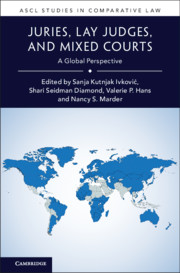Book contents
- ASCL Studies In Comparative Law
- Juries, Lay Judges, and Mixed Courts
- Copyright page
- Contents
- Editors
- Contributors
- Acknowledgments
- 1 Introduction
- Part I Advances in Lay Participation
- 2 The Rise of the Jury in Argentina
- 3 Twelve Years of Mixed Tribunals in Argentina
- 4 Lay Participation in the Criminal Trial in Japan
- 5 The Korean Jury System
- 6 The Twenty-Fifth Anniversary of the Spanish Jury
- Part II Enduring Systems of Lay Participation
- Part III Challenges to Lay Participation in Law
- Part IV Global Perspectives on Lay Participation
- Name Index
- Subject Index
- References
4 - Lay Participation in the Criminal Trial in Japan
A Decade of Activity and Its Sociopolitical Consequences
from Part I - Advances in Lay Participation
Published online by Cambridge University Press: 03 August 2021
- ASCL Studies In Comparative Law
- Juries, Lay Judges, and Mixed Courts
- Copyright page
- Contents
- Editors
- Contributors
- Acknowledgments
- 1 Introduction
- Part I Advances in Lay Participation
- 2 The Rise of the Jury in Argentina
- 3 Twelve Years of Mixed Tribunals in Argentina
- 4 Lay Participation in the Criminal Trial in Japan
- 5 The Korean Jury System
- 6 The Twenty-Fifth Anniversary of the Spanish Jury
- Part II Enduring Systems of Lay Participation
- Part III Challenges to Lay Participation in Law
- Part IV Global Perspectives on Lay Participation
- Name Index
- Subject Index
- References
Summary
Ten years have passed since the lay judge or Saiban’in system was introduced in Japan in 2009. Not only did this have a significant impact on the way the criminal court operates, but it also represented an important step in raising the legal consciousness of citizens regarding state affairs. This chapter has three objectives. First, we present a brief history of the varied systems of lay participation adopted in Japan and examine the sociopolitical context in which the most recent system of Saiban’in trial was introduced. Second, we analyze the functioning of the lay judge system in its first decade of operation. Finally, we examine the sociopolitical consequences of the lay judge system in relation to: (a) Saiban’in trials of foreign military personnel stationed in Okinawa; (b) the contribution of the Former Lay Judge Network to calls for the abolition of the death penalty; and (c) the role of former Saiban’in in the 2016 implementation of recording and videotaping of interrogations. We conclude by examining the future of the lay participation system in Japan.
- Type
- Chapter
- Information
- Juries, Lay Judges, and Mixed CourtsA Global Perspective, pp. 69 - 87Publisher: Cambridge University PressPrint publication year: 2021
References
- 2
- Cited by

